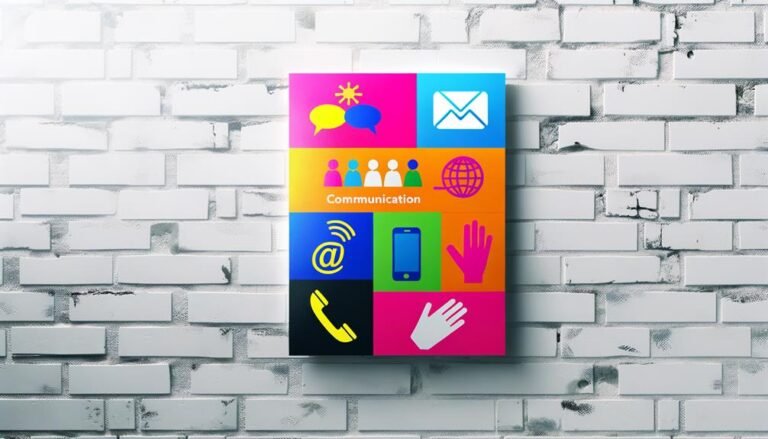Efficiency as a Soft Skill
|
Getting your Trinity Audio player ready...
|
Efficiency as a soft skill empowers you to optimize performance, enhance productivity, and reduce stress in the workplace by managing time and resources strategically. Prioritize tasks effectively based on importance and urgency. Streamline processes to identify and eliminate bottlenecks for clarity and consistency. Maximize time management by delegating tasks, setting realistic deadlines, and tackling high-priority items first. Utilize tools like calendars, task managers, and automation for efficiency gains. Collaboration fosters peak efficiency through effective communication and teamwork dynamics. Measuring and improving efficiency through tracking methods and time-saving techniques leads to enhanced productivity. Discover more benefits by embracing efficiency in the workplace.
Key Takeaways
- Efficiency as a soft skill involves optimizing processes for productivity.
- It includes time management, organization, and effective task prioritization.
- Efficiency reduces stress, enhances performance, and boosts job satisfaction.
- Developing efficiency skills leads to better resource utilization and improved outcomes.
- Embracing efficiency as a soft skill offers numerous benefits in personal and professional settings.
The Importance of Efficiency
Efficiency is the cornerstone of productivity in any work setting, enabling individuals to achieve peak results with minimal time and effort. The importance of efficiency can't be overstated in the modern workplace. By optimizing processes and streamlining tasks, efficiency guarantees that valuable resources such as time, energy, and money are utilized effectively. One of the key benefits of prioritizing efficiency is the ability to accomplish more in less time, ultimately leading to increased output and performance. This not only boosts individual productivity but also contributes to the overall success of the team and organization.
Moreover, efficiency plays a pivotal role in reducing stress and burnout. When tasks are completed efficiently, it alleviates the pressure of looming deadlines and allows for a better work-life balance. Additionally, efficiency fosters a sense of accomplishment and motivation, as individuals witness the tangible results of their streamlined efforts. Embracing efficiency as a soft skill is, hence, a strategic decision that can yield numerous benefits for both individuals and organizations alike.
Developing Efficiency Skills
To enhance your proficiency in completing tasks effectively and in a timely manner, it's essential to focus on refining your time management and organizational skills. Improving workflows is a key aspect of developing efficiency skills.
Start by analyzing how you currently approach your tasks. Look for areas where you can streamline processes, eliminate unnecessary steps, and optimize the sequence of activities. By doing so, you can make your workflow more efficient and reduce the time spent on each task.
Time optimization is another vital element in enhancing your efficiency. Identify time-wasting activities or habits that hinder your productivity. Create a schedule that allocates specific time slots for different tasks, ensuring that you make the most out of your day. Utilize tools like calendars, to-do lists, or productivity apps to help you stay organized and on track.
Prioritizing Tasks Effectively
Enhance your task completion by effectively prioritizing your workload based on importance and urgency. Effective prioritization is a key aspect of time management, allowing you to focus your energy on tasks that matter most.
Start by creating a list of all the tasks you need to complete, then assess each task's importance and deadline. Prioritize tasks that are both important and urgent, guaranteeing they're completed promptly.
Consider using tools such as to-do lists or digital task managers to help you organize and prioritize your tasks efficiently. Break down larger tasks into smaller, more manageable subtasks to make them less overwhelming. By tackling high-priority tasks first, you can make significant progress and avoid feeling overwhelmed by looming deadlines.
Remember to be flexible in your prioritization approach, as unexpected tasks or deadlines may arise. Review and adjust your priorities regularly to ensure you're always focusing on the most critical tasks. By mastering the art of effective prioritization, you can boost your productivity and accomplish more in less time.
Streamlining Processes for Productivity
Consider streamlining your processes to boost productivity and efficiency in your workflow. When it comes to process optimization and workflow enhancement, making small changes can have a significant impact on your overall efficiency. Here are some practical tips to help streamline your processes:
| Process Optimization | Workflow Enhancement |
|---|---|
| Identify bottlenecks and eliminate them | Automate repetitive tasks |
| Simplify complex procedures for clarity | Establish clear communication channels |
| Utilize technology for efficiency | Implement task prioritization strategies |
| Standardize processes for consistency | Delegate tasks effectively |
| Continuously review and improve workflows | Set realistic goals and deadlines |
Maximizing Time Management Skills
Maximize your productivity by honing your time management skills efficiently. Effective task delegation is vital in guaranteeing that tasks are completed in a timely manner. Identify tasks that can be assigned to others, considering their strengths and workload, to optimize efficiency.
Time blocking strategies can help you allocate specific time slots for different activities, increasing focus and productivity. By scheduling dedicated blocks of time for tasks like emails, meetings, and project work, you can minimize distractions and work more effectively.
Prioritize tasks based on urgency and importance to tackle high-priority items first. This approach ensures that critical tasks are completed promptly, preventing last-minute rushes and stress. Additionally, set realistic deadlines for each task to maintain a steady workflow and avoid procrastination.
Efficiency in Communication
When communicating efficiently, focus on being clear and concise in your messages. Set clear expectations for timely responses to guarantee smooth interactions.
Streamlining communication processes can help save time and prevent misunderstandings.
Clear and Concise Messaging
To enhance efficiency in communication, endeavor to craft clear and concise messages that convey information effectively. When aiming for effective communication and concise writing, consider the following tips:
- Know Your Audience: Tailor your message to suit the recipient's level of understanding and familiarity with the subject matter.
- Use Simple Language: Avoid jargon and complex terms that could cause confusion or misinterpretation.
- Stick to the Point: Focus on the key information you want to convey without unnecessary details or tangents.
- Be Mindful of Tone: Guarantee your message strikes the right tone for the situation, whether formal, friendly, or urgent.
Timely Response Expectations
Crafting clear and concise messages is fundamental in ensuring timely responses and maintaining efficiency in communication. Setting expectations for response times is vital. Clearly communicate when a response is needed, whether it's by the end of the day or within a specific timeframe.
Utilize communication strategies such as setting up automated acknowledgments for received messages to reassure the sender that their message was received and will be addressed promptly. Additionally, establish guidelines for urgent versus non-urgent matters to prioritize responses effectively.
Streamlining Communication Processes
Efficient communication processes are vital for optimizing productivity and fostering effective collaboration within a team or organization. When it comes to enhancing communication, reducing redundancies is crucial.
Here are four ways to streamline your communication processes:
- Clear Objectives: Make sure that every message has a clear purpose to avoid confusion.
- Concise Messaging: Get straight to the point to save time for both the sender and receiver.
- Use of Technology: Utilize tools like project management platforms or instant messaging for quick and efficient communication.
- Feedback Loops: Establish feedback mechanisms to ensure that information is understood and acted upon promptly.
Tools for Enhancing Efficiency
Utilizing the proper tools can greatly enhance your efficiency in various tasks and projects. When it comes to improving workflows and implementing time-saving techniques, having the right tools at your disposal is essential. One essential tool for enhancing efficiency is project management software. These platforms allow you to organize tasks, set deadlines, and track progress all in one place, streamlining your workflow and ensuring that nothing falls through the cracks.
Additionally, using communication tools such as Slack or Microsoft Teams can help facilitate quick and efficient information sharing among team members, cutting down on time spent searching for emails or waiting for responses. These tools also often offer integrations with other software, further optimizing your workflow.
Automation tools like Zapier or IFTTT can save you valuable time by automating repetitive tasks, freeing you up to focus on more important aspects of your work. By incorporating these tools into your daily routine, you can significantly enhance your efficiency and productivity.
Collaboration for Optimal Efficiency
To maximize efficiency in your workflow, effective collaboration among team members is essential for achieving the best results. When working together towards a common goal, here are some key aspects to take into account for peak efficiency:
- Clear Communication: Establish open channels of communication to guarantee everyone is on the same page. Encourage team members to ask questions, provide updates, and share ideas freely.
- Defined Roles and Responsibilities: Clearly outline each team member's role and responsibilities to avoid duplication of efforts and minimize confusion. Task delegation based on individual strengths can lead to higher productivity.
- Respect for Teamwork Dynamics: Understand and respect the diverse perspectives, working styles, and strengths of each team member. Embrace the unique qualities that each individual brings to the table.
- Constructive Feedback: Provide constructive feedback to help team members improve their performance. Encourage a culture of continuous improvement and learning within the team.
Measuring and Improving Efficiency
To enhance your efficiency, consider employing various methods such as time tracking, streamlining processes, and utilizing automation tools.
These points are essential in measuring and improving your productivity levels, allowing you to identify areas where you can optimize your workflow.
Time Tracking Methods
Tracking your time effectively is essential for measuring and improving efficiency in your work. Here are four popular time tracking methods to help you stay on top of your tasks:
- Pomodoro Technique: Break your work into intervals, traditionally 25 minutes of focused work followed by a 5-minute break. This method boosts productivity by providing regular breaks.
- Time Blocking: Allocate specific time slots for different tasks throughout your day. This helps in focusing on one task at a time and avoiding multitasking.
- Digital Time Trackers: Use apps like Toggl or Clockify to monitor the time spent on different activities accurately.
- Analog Methods: Try using a physical planner or a simple spreadsheet to jot down your daily tasks and track the time spent on each.
Implementing these methods can enhance your efficiency and productivity.
Streamlining Processes
Measuring and improving efficiency through streamlining processes is essential for enhancing productivity in your work. Improving workflows involves analyzing current processes to identify bottlenecks and inefficiencies. By optimizing these workflows, you can reduce waste, eliminate unnecessary steps, and enhance overall performance.
Consider mapping out your processes to visualize the flow of tasks and identify areas for improvement. Look for opportunities to standardize procedures, automate repetitive tasks, and delegate responsibilities effectively. Regularly reviewing and refining your processes will help you adapt to changing demands and increase efficiency over time.
Automation Tools
Efficiency in your work can be greatly enhanced through the strategic implementation of automation tools. These tools offer numerous benefits, such as reducing manual errors, increasing productivity, and enabling you to focus on high-value tasks.
However, implementing automation comes with its challenges, like initial setup time and costs. To guarantee you're maximizing efficiency through automation, consider the following:
- Define Your Goals: Clearly outline what you aim to achieve with automation.
- Track Efficiency Metrics: Measure the impact of automation on your workflow.
- Regular Performance Evaluation: Continuously assess the effectiveness of the tools in place.
- Adapt and Improve: Be open to adjusting your automation strategy to enhance efficiency further.
Benefits of Efficiency in the Workplace
Enhancing workplace efficiency can lead to a myriad of advantages for both employees and the organization as a whole. By implementing time-saving techniques and mastering effective multitasking, employees can accomplish more in less time, boosting productivity and reducing stress levels. Workflow optimization guarantees that tasks are streamlined and completed in a logical sequence, minimizing delays and errors. Task prioritization allows individuals to focus on high-impact activities, leading to better outcomes and overall performance.
Efficiency in the workplace also translates into improved job satisfaction and work-life balance for employees. When tasks are completed more efficiently, employees have more time to dedicate to personal pursuits or additional projects, fostering a sense of fulfillment and motivation. Additionally, organizations benefit from increased profitability, as time and resources are utilized more effectively. Enhanced efficiency can also result in a competitive edge, allowing the company to adapt quickly to changes in the market and stay ahead of the competition. Embracing efficiency as a core principle ultimately creates a positive and thriving work environment for all.
Conclusion
In summary, mastering efficiency as a soft skill is essential for success in the workplace. By prioritizing tasks, streamlining processes, and maximizing time management skills, you can work smarter, not harder.
Remember, 'time is money' and being efficient allows you to make the most of both. Keep honing your efficiency skills to achieve peak results and stand out as a valuable asset in any professional setting.








